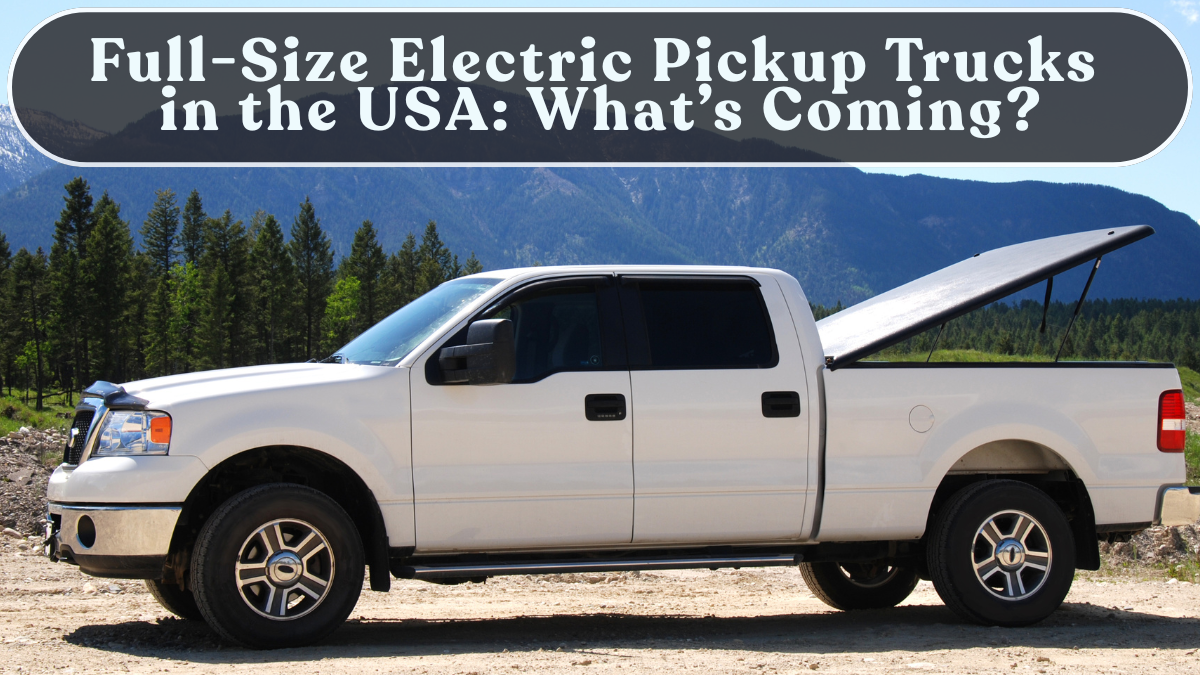The American love affair with pickup trucks is evolving into the electric era. From Ford’s F-150 Lightning to Rivian’s R1T and Tesla’s Cybertruck, the full-size electric pickup truck segment has quickly become one of the most competitive categories in the automotive world. What started as a niche experiment is now a full-scale movement toward zero-emission utility vehicles that promise power without pollution.

The Rise of Electric Pickup Trucks
Pickup trucks have long been the heart of the US auto market. In 2025, over 3 million pickup trucks are sold annually — and a growing share of them are now electric. Manufacturers are racing to electrify their most popular models, offering traditional toughness with futuristic technology.
Several factors are driving this revolution:
-
Government incentives and tax credits for EVs.
-
Corporate sustainability goals pushing fleet electrification.
-
Consumer demand for high-performance yet eco-friendly options.
-
Advancements in battery tech enabling long-range towing and payload capacities.
The result? EV trucks that are more than capable of replacing their gas-powered predecessors.
Top Electric Pickup Trucks Hitting the US Market
| Model | Range (mi) | Towing Capacity (lbs) | Starting Price (USD) | Highlights |
|---|---|---|---|---|
| Ford F-150 Lightning | 320 | 10,000 | $54,995 | Dual motors, Pro Power Onboard, BlueCruise |
| Rivian R1T | 340 | 11,000 | $73,000 | Adventure mode, independent suspension |
| Chevrolet Silverado EV | 400 | 10,000 | $74,800 | Ultium platform, 800 V architecture |
| GMC Hummer EV Truck | 350 | 12,000 | $96,000 | CrabWalk, Extract Mode, off-road monster |
| Tesla Cybertruck | 340 | 11,000 | $79,990 | Stainless-steel body, futuristic design |
These trucks prove that electrification no longer means compromise — they deliver torque, range, and performance to match or exceed internal-combustion rivals.
Performance & Technology Highlights
Modern electric pickups are redefining what power means on the road. The instant torque from electric motors provides breathtaking acceleration and towing capability.
-
The F-150 Lightning can hit 0–60 mph in just 4.0 seconds.
-
Rivian R1T’s quad-motor setup offers precise off-road handling.
-
Chevy Silverado EV features a massive 200 kWh battery with DC fast-charging.
-
Tesla’s Cybertruck introduces steer-by-wire and bullet-resistant body panels.
These vehicles aren’t just workhorses — they’re rolling tech platforms equipped with AI-driven infotainment, over-the-air updates, and advanced driver assistance systems (ADAS).
Charging and Infrastructure Progress
A key enabler of electric truck adoption is America’s growing charging network. By mid-2025, there are over 190,000 public EV chargers across the country, many offering 350 kW ultra-fast capability.
Manufacturers are also integrating bi-directional charging, allowing trucks to power homes, tools, or even other EVs. Ford’s “Pro Power Onboard” feature, for example, can power a house for up to three days during outages.
Additionally, charging partnerships like GM + Pilot Company’s 2,000-station rollout and Tesla’s open Supercharger network are rapidly improving accessibility for heavy-duty EVs.
Environmental and Economic Benefits
The shift to electric pickups represents more than just a trend — it’s a sustainability milestone. Each EV truck can save up to 50 tons of CO₂ emissions over its lifetime compared to a diesel equivalent.
Economically, the cost-per-mile is significantly lower:
-
Electricity: ≈ $0.04–$0.06 per mile
-
Gasoline: ≈ $0.15–$0.20 per mile
Fleets switching to electric models are seeing 30–40% reductions in operational costs, while also aligning with ESG (Environmental, Social, and Governance) mandates.
Challenges That Remain
Despite the excitement, a few roadblocks persist:
-
High upfront cost: Battery technology remains expensive.
-
Towing range loss: Heavy loads can reduce range by 30–40%.
-
Charging time: Even fast chargers require 30–45 minutes for full capacity.
-
Limited rural coverage: Infrastructure growth is still concentrated near cities.
However, with federal and state investments and advancements in solid-state batteries, these challenges are being steadily resolved.
The Road Ahead
Experts predict that electric pickups will make up 25% of all truck sales by 2030. Manufacturers are planning smaller, affordable variants to appeal to mass consumers. Upcoming models like the RAM 1500 REV and Toyota Tacoma EV are expected to broaden the segment further.
As battery costs fall and infrastructure grows, electric pickups will become the new norm — combining the classic American work ethic with modern clean energy.
Conclusion
The full-size electric pickup truck boom in the USA signals a transformative era for both automakers and consumers. With unrivaled torque, high-tech features, and zero tailpipe emissions, these machines are redefining what it means to drive a truck. The days of noisy engines and gas-station stops are fading fast — the future of American power is electric, silent, and unstoppable.
FAQs
Which is the most popular electric pickup truck in the USA?
The Ford F-150 Lightning currently leads the market in both sales and brand trust.
How long does it take to charge an electric pickup?
Fast chargers can replenish 80% of battery capacity in about 30 minutes.
Can electric pickups tow as much as diesel trucks?
Yes, many models like Rivian R1T and Silverado EV offer over 10,000 lbs towing capacity.
What’s the average cost of an electric pickup in 2025?
Prices range between $55,000 and $95,000, depending on model and trim.
Are electric trucks practical for long road trips?
Yes, with improved fast-charging networks and 300+ mile ranges, electric pickups are now road-trip-ready.
